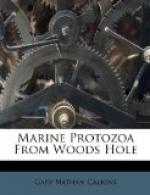The cup is elongated, swollen centrally, tapering at oral end and conical at base or rounded. Oral opening either circular or elliptical. Cross rings may or may not be present, and the cup is either smooth or annulate. Length of cup 70 mu to 80 mu. The stalk which supports the cup is extremely variable in length. The animal is borne upon a stalk of variable length within the cup.
Entz states that the many variations which this species exhibits run into each other so gradually that he does not believe it wise to separate them. The Woods Hole forms which I found on algae of various kinds were nearly of a size, and did not vary much from the one figured. Kellicott ’94 described a Cothurnia from Woods Hole under the name of C. longipes, which I believe is only a long-stemmed variety of C. nodosa. My form has the following dimensions: Cup 75 mu; cup stalk 38 mu; animal stalk 14 mu.
[Illustration: Fig. 64.—Cothurnia nodosa.]
KEY TO FAMILIES OF SUCTORIA.
a. Unattached forms; ventral cilia Hypocomidae
present; one suctorial tentacle
b. Attached forms; thecate and Urnulidae
athecate tentacles simple,
one or two in number
c. Thecate; posterior end of cup Metacinetidae
drawn out into stalk; walls
perforated for exit of tentacles
d. Stalked or unstalked; globular; Podophryidae
tentacles of different kinds, some
(2 genera *_Ephelota_,
knobbed, others pointed
*_Podophrya_)
e. Naked or thecate; stalked or not; Acinetidae
tentacles numerous, usually
knobbed and all alike
f. Naked; athecate; tentacles Dendrosomidae
numerous, all alike, knobbed and
grouped in tufts. They may
be
simple or branched.
g. Sessile forms resting on basal Dendrocometidae
surface or on a portion raised
like a stalk; tentacles many;
short and knobbed; distributed
on apical surface or localized
on branched arms
h. Stalked or sessile; tentacles Ophryodendridae
long, rarely knobbed, supported
on proboscis-like processes
* Presence at Woods Hole indicated by asterisk.
Genus PODOPHRYA Ehr. ’33.
(Buetschli ’88; Stein ’59; Perty ’52;
Cienkowsky ’55; Quenn. ’69;
Hertwig ’77; Maupas ’81.)
The body is globular, with tentacles radiating in all directions. The tentacles may be very short or very long. The stalk also is either short or long, and some species form stalks but rarely (P. libera). The macronucleus is centrally placed and globular to ovoid in form. The contractile vacuole is usually single. Reproduction takes place by division; the distal half developing cilia and becoming a swarm-spore. Fresh and salt water.




